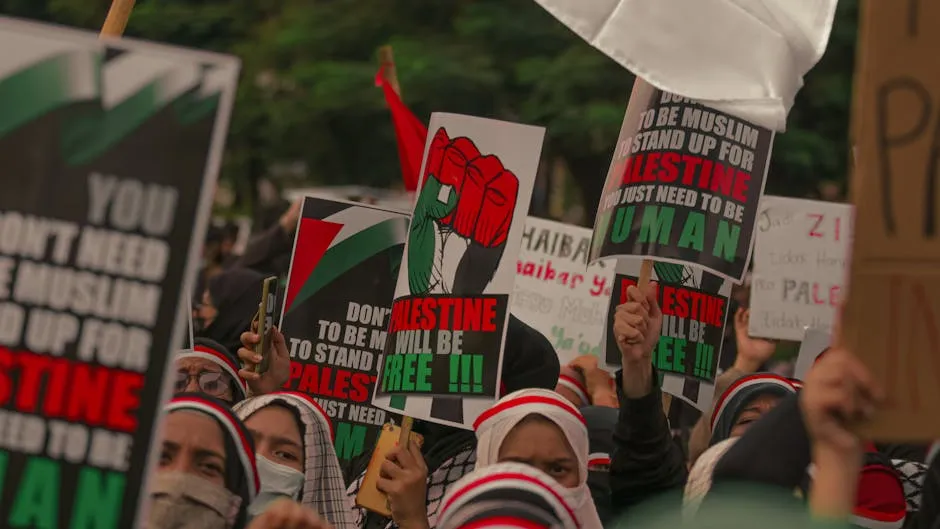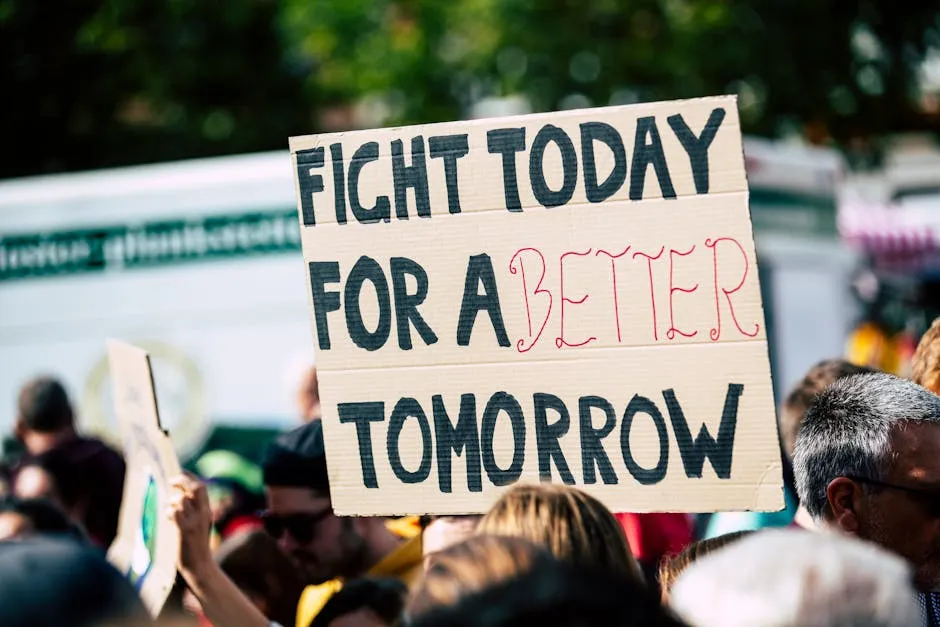
Why Are People Protesting at Colleges?
Introduction
College protests have surged recently. Students are voicing their concerns about social and political issues. A notable trigger has been the Israel-Hamas conflict, which has intensified activism on campuses. This section will explore the motivations behind these protests, their demands, and how universities are responding.
If you’re looking to understand the dynamics of protests and activism, you might find The Protest Handbook: A Guide to Organizing for Change a must-read. This book breaks down how to effectively mobilize and organize for social causes, making it a great companion for any aspiring activist.

Summary and Overview
Student activism is on the rise, especially in response to pressing social issues. Recent statistics reveal that over 80 U.S. campuses have hosted demonstrations related to the Israel-Gaza conflict. Many students are calling for divestment from companies linked to military actions against Palestinians. They also demand that universities cut ties with entities that support these actions.
These protests highlight broader societal divisions regarding the Israeli-Palestinian conflict. Many students feel compelled to speak out against what they perceive as injustices. Their voices reflect a growing urgency for change and accountability within academic institutions. The protests are not just about one issue but encompass a range of concerns that resonate deeply within the student body.
To gain a deeper understanding of systemic issues that lead to such activism, consider reading The New Jim Crow: Mass Incarceration in the Age of Colorblindness. This eye-opening book delves into the intersections of race and justice, which can provide context to many students’ motivations for activism today.

The Context of College Protests
Historical Background of Student Protests
Student protests have a rich history in the U.S. From the Vietnam War to the Civil Rights Movement, young voices have always challenged the status quo. In the 1960s, students rallied against U.S. involvement in Vietnam. They called for peace and questioned the government’s motives. This activism laid the groundwork for future movements and highlighted the importance of free speech in academia.
Throughout the decades, student activism has evolved. In the 1970s and 1980s, protests addressed issues like apartheid in South Africa and environmental concerns. More recently, movements such as Black Lives Matter and climate activism have emerged. Each wave reflects the pressing issues of the time and shows students’ desire to influence change.

Recent Trigger Events
The recent surge in college protests stems from the Israel-Hamas conflict. The escalation began on October 7, 2023, when Hamas attacked Israel. This led to significant Israeli military responses. The conflict has resulted in thousands of casualties, igniting outrage and calls for action among students.
On April 17, 2024, protests erupted at Columbia University. Students set up encampments to voice their demands. These encampments were met with police intervention, resulting in over 100 arrests. This incident quickly sparked similar protests at various universities across the nation.

For a thought-provoking perspective on the power of peaceful protests, consider reading This Is an Uprising: How Nonviolent Revolt is Shaping the Twenty-First Century. It sheds light on how nonviolent actions can lead to substantial change.
In the days that followed, protests intensified. Notable incidents occurred at New York University, Yale, and the University of Southern California. Each event fueled national dialogue and further mobilization. Students across campuses demanded their universities divest from companies linked to military actions in Gaza. Their voices are a powerful testament to the urgency they feel about the situation.

Key Motivations Behind Protests
Advocacy for Palestinian Rights
Many students are advocating for Palestinian rights. This pro-Palestinian stance stems from deep humanitarian concerns. Protesters are calling for a ceasefire and urgent humanitarian aid. They believe the current situation in Gaza is dire, with countless lives at stake. Universities are being urged to take action. Specific demands include halting investments in companies linked to military actions. Students want transparency regarding university financial ties to entities involved in the conflict. They feel that their schools should prioritize human rights over profit.

To understand the broader implications of social justice movements, check out Freedom of Speech: Mightier Than the Sword. This book provides a compelling analysis of the importance of free expression in activism.
Calls for University Divestment
The Boycott, Divestment, and Sanctions (BDS) movement plays a significant role in these protests. Its goal is to pressure universities to divest from companies supporting Israel’s military efforts. Students are demanding that their institutions cut financial ties with these entities. Some notable universities are facing increased pressure to comply. Institutions like Columbia and NYU have seen significant activism surrounding divestment. The impact of these demands could be substantial, affecting university endowments and future investments. Students believe that divestment sends a powerful message about their values.

To dive deeper into the history of systemic injustice in America, consider reading The Color of Law: A Forgotten History of How Our Government Segregated America. It’s a powerful read that illuminates how government policies have shaped societal structures.
Impact on Jewish Students
The protests have significant implications for Jewish students on campus. Many are concerned about rising antisemitism and their safety. As protests intensify, statements from Jewish organizations reflect these worries. They emphasize the need for universities to ensure a safe environment for all students. Some institutions have implemented measures to address these concerns, like increasing security. The situation is complex, as students from various backgrounds engage in activism. Balancing free speech and safety remains a primary challenge for universities during these turbulent times.

University Responses to Protests
Administrative Actions
Universities are responding to protests in diverse ways. Their actions often depend on whether they are public or private institutions. Public universities tend to face stricter scrutiny. They must adhere to First Amendment rights, which can complicate their response strategies. Private universities usually have more flexibility in enforcing their policies.
For instance, Columbia University saw significant protests leading to multiple arrests. Over 100 students were detained when police intervened to clear encampments. Similarly, Yale and NYU experienced similar situations, with numerous arrests as tensions escalated. These instances highlight how police involvement can quickly escalate the situation, leading to further unrest.

To explore the implications of student activism, check out A People’s History of the New American Empire. This book offers valuable insights into the historical context of resistance movements.
Balancing Free Speech and Safety
Navigating the legal implications of protests is a complex task for universities. They must uphold free speech while ensuring the safety of all students. Laws such as Title VI of the Civil Rights Act mandate a safe learning environment. This responsibility complicates how universities handle protests.
Universities often establish guidelines to manage protest activities. These regulations focus on time, place, and manner restrictions. For example, some institutions have designated specific areas for protests to minimize disruption. Successful negotiations between students and administration can lead to agreements that satisfy both parties.

One notable example occurred at Northwestern University, where students and administrators reached a compromise on encampment sizes. This type of negotiation illustrates that mutual understanding is possible, even amid heightened tensions.
Ultimately, universities are at a crossroads. They must foster an environment where students feel safe to express their views while also protecting the rights of everyone on campus. The challenge is ongoing, as protests continue to evolve alongside societal issues.

The Broader Social and Political Implications
Political Reactions
Political leaders are paying close attention to campus protests. Their responses vary, reflecting the complex nature of the issues at hand. Some local and federal politicians have condemned the protests. They highlight concerns about rising antisemitism during these demonstrations. For instance, House Speaker Mike Johnson called for accountability, urging the arrest of those who promote violence.
On the other hand, figures like Rep. Alexandria Ocasio-Cortez have criticized the handling of protests by university administrations. They advocate for the right to protest while emphasizing the need for peaceful dialogue. Social media plays a crucial role in shaping public perception. It amplifies voices of both supporters and opponents of the protests, creating a dynamic discourse. This digital landscape allows for rapid dissemination of information, often leading to heightened emotions.

For a deeper dive into the dynamics of protest movements, consider reading How to Change the World: Social Entrepreneurs and the Power of New Ideas. This book sheds light on innovative approaches to activism and social change.
Global Context of Protests
U.S. college protests are part of a global wave of student activism. Similar movements have emerged in countries like Canada, the UK, and Australia. These protests often address issues such as human rights, climate change, and social justice. The common thread is a desire for change and accountability from institutions.

In Israel, student demonstrations have also gained momentum, pushing for an end to military actions in Gaza. Students worldwide are connecting local issues to global movements, creating a sense of solidarity. The protests highlight a shared commitment to advocating for justice and equity.
For further insights into the historical context of social movements, consider A People’s History of the United States. This book provides a critical examination of American history through the lens of marginalized voices.

Conclusion
In summary, college protests are more than isolated events. They reflect broader societal divisions and the urgent need for dialogue. Ongoing protests challenge universities to consider their roles in political discourse. As students continue advocating for their beliefs, the future of higher education and student activism hangs in the balance. Let’s think critically about how these developments shape our understanding of free speech and civic engagement.
Encourage discussions about the role of universities in fostering healthy political dialogue. Share your thoughts and engage with local activism to support the students’ voices.
Please let us know what you think about our content by leaving a comment down below!
Thank you for reading till here 🙂
All images from Pexels




